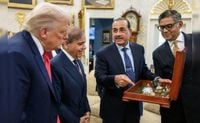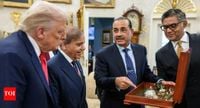In a move that has sparked both hope and controversy, Pakistan’s top leadership showcased the country’s rare earth mineral potential to U.S. President Donald Trump at the White House on September 25, 2025. The meeting, which took place on the sidelines of the United Nations General Assembly, featured Prime Minister Shehbaz Sharif and Army Chief General Asim Munir presenting an open wooden box filled with colorful mineral samples—reportedly including bastnazite and monazite, which are known to bear rare earth elements such as cerium, lanthanum, and neodymium—to President Trump. The gesture was widely interpreted as a signal of Pakistan’s eagerness to forge new economic partnerships and attract American investment into its long-touted but largely untapped mineral sector.
The meeting was more than a photo opportunity. According to The Economic Times and Times of India, the display of mineral samples came just weeks after Pakistan’s Frontier Works Organisation (FWO)—a military-linked engineering and mining group—signed a $500 million memorandum of understanding (MoU) with Missouri-based US Strategic Metals (USSM). The agreement, inked on September 8, 2025, lays out a three-phase plan for mineral exports, processing, and large-scale exploration projects in Pakistan, with a specific focus on antimony, copper, gold, tungsten, and rare earth elements.
Phase one of the MoU, set for 2025–2026, will see the immediate export of readily available minerals such as antimony and copper concentrates to U.S. markets. This phase is expected to generate quick revenue for Pakistan, which is currently grappling with a prolonged financial crisis. The second phase, scheduled for 2026–2028, involves constructing processing plants and refineries in Pakistan, with an emphasis on technology transfer for rare earth element (REE) separation and purification. The third and most ambitious phase, beginning in 2028, envisions large-scale exploration and the development of five to ten mining projects in high-potential REE belts—primarily in the restive Balochistan and Khyber-Pakhtunkhwa regions.
While the mineral samples were the centerpiece of the White House meeting, the encounter was rich in symbolism. Prime Minister Sharif wore a lapel pin featuring both the U.S. and Pakistani flags, a gesture that drew mixed reactions back home. Some Pakistani social media users mocked the move as "embarrassing," while others saw it as a step toward mending ties with Washington after years of strained relations. The meeting itself was notable for its high-profile attendees: in addition to President Trump, Vice President JD Vance and Secretary of State Marco Rubio participated, and the talks reportedly lasted about an hour and a half.
Sharif, in a statement from his office, described Trump as a “man of peace” for his “sincere efforts” to end conflicts around the globe. He expressed confidence that under Trump’s leadership, the Pakistan-U.S. partnership would be “further strengthened to the mutual benefit of both countries.” Sharif also thanked Trump for a tariff deal signed in July 2025, which set a 19 percent tariff on Pakistani imports and included U.S. assistance in developing Pakistan’s oil reserves. The prime minister used the occasion to invite American companies to invest in Pakistan’s agriculture, IT, mining, minerals, and energy sectors, emphasizing the country’s potential as a destination for foreign capital.
The rare earths gambit comes at a time when global supply chains for these critical minerals are under intense scrutiny. China currently dominates the world’s rare earths market and supplies the bulk of the United States’ needs. Pakistan’s overture to the U.S. is seen by some analysts as a strategic bid to reduce Chinese influence and offer Washington an alternative source of these vital materials. According to Times of India, experts noted that Pakistan had previously granted China exclusive mining rights in Balochistan and Khyber Pakhtunkhwa, but the new agreements with U.S. firms could shift the balance of access toward the United States.
Yet, the deals have ignited a heated debate within Pakistan. Critics, including opposition parties and some civil society groups, argue that the government is preparing to "sell Pakistan’s land and treasure to foreign powers." They point to the lack of binding mining licenses in the initial agreements as evidence that the deals are more about signaling than substance. Supporters, on the other hand, contend that attracting foreign investment is essential for strengthening Pakistan’s faltering economy and reducing its reliance on massive foreign loans. The government maintains that the country’s mineral reserves are worth trillions of dollars, and that foreign capital and expertise could help unlock this potential.
Adding another layer to the diplomatic flurry, British-Pakistani entrepreneur Bilal bin Saqib—informally dubbed Pakistan’s “Minister of Crypto”—met with Trump’s Crypto Adviser, Patrick Witt, on the sidelines of the White House meeting. Their discussions focused on avenues of collaboration in the digital assets space, signaling Islamabad’s interest in positioning itself as a player in the global cryptocurrency market. Bin Saqib was later seen at the UN General Assembly promoting cryptocurrency during Sharif’s speech, further underscoring Pakistan’s efforts to diversify its economic partnerships.
The White House meeting also featured an unexpected participant: FBI Director Kash Patel. The presence of Patel, who reportedly met separately with Munir and Sharif, raised eyebrows and fueled speculation about ongoing security and extradition issues between the two countries. Over the years, Pakistan has extradited or handed over several nationals facing terrorism charges against U.S. interests, often in exchange for financial incentives.
While the agreements with USSM and the Portuguese engineering firm Mota-Engil Group are still in their early stages, both sides have expressed readiness to develop value-added facilities, enhance mineral processing capacity, and undertake large-scale mining projects. A statement from Sharif’s office emphasized that the partnership would "begin immediately with the export of readily available minerals from Pakistan, including antimony, copper, gold, tungsten, and rare earth elements." The government hopes these initiatives will attract further investment and help the country overcome its financial challenges.
However, significant obstacles remain. Most of Pakistan’s mineral wealth is concentrated in Balochistan, a province plagued by insurgency and separatist violence. Local groups have long opposed the extraction of resources by both Pakistani and foreign firms, citing concerns over environmental degradation and the marginalization of local communities. These security and political challenges could complicate the implementation of the ambitious mining projects envisioned in the MoU.
As Pakistan’s leadership courts American investment and flashes its mineral potential on the world stage, the country stands at a crossroads. Whether these high-profile overtures will translate into tangible economic benefits—or merely fuel further controversy—remains to be seen. For now, the rare earths showcase at the White House has put Pakistan’s mineral riches back in the global spotlight and opened a new chapter in its complex relationship with the United States.

